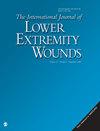单中心、单盲、前瞻性研究:利用护理点细菌蛋白酶活性测试鉴定高风险下肢伤口
IF 1.5
4区 医学
Q3 DERMATOLOGY
引用次数: 0
摘要
临床医生主要通过观察红斑、脓液和气味来判断伤口是否感染。然而,无法察觉的细菌蛋白酶活性会延迟伤口愈合并导致并发症。本研究评估了一种检测细菌蛋白酶活性(BPA,用 Woundchek 细菌状态检测仪检测)的护理点检测方法。在血管和足病诊所共招募了 130 名下肢伤口患者,在临床医生进行初步(盲法)伤口评估后,在两个时间点进行了 182 次 BPA 测试。临床意见("无感染"、"可能 "或 "确定 "感染)与 BPA 结果(阴性或阳性测试)的 Kendall's tau-c 等级相关系数为 0.32(P < 0.001)。二元逻辑回归分析和主成分分析表明,根据临床意见确定的感染与上述临床症状和 BPA 检测呈阳性有显著相关性。然而,BPA 阳性结果与伤口严重程度,如病变数量、慢性程度和大小也有明显关联。在为期 12 周的随访中,基线(P 0.001)和第 12 周(P 0.036;均为 Mann-Whitney U 检验)BPA 检测呈阳性的伤口溃疡面积中位数分别较大。作为一项试点措施,临床人员可以根据 BPA 检测结果采取相应措施;在 71 例检测呈阳性的病例中,有 11 例(15%)采取了这种措施,并使用了抗菌敷料,而不是按计划使用标准敷料。这些结果表明,释放蛋白酶的细菌可能活跃于(尚未)出现感染标志性症状的溃疡中,并与延迟愈合有关。对细菌蛋白酶活性进行有针对性的护理点检测,有可能识别出这些高风险伤口,并对其进行积极的(抗菌)管理。本文章由计算机程序翻译,如有差异,请以英文原文为准。
Identification of High-Risk Lower Extremity Wounds Using Point-of-Care Test for Bacterial Protease Activity; A Single-Centre, Single-Blinded, Prospective Study
Clinician observation is the mainstay to determine if wound infection is present, and focuses on presence of erythema, purulence, and odour. However, non-visible bacterial protease activity can delay wound healing and lead to complications. In this study, a point-of-care test to detect the presence of bacterial protease activity (BPA, tested with Woundchek Bacterial Status test) was appraised. A total of 130 patients with lower extremity wounds were recruited in vascular and podiatry clinics, and across two time-points 182 BPA tests were conducted subsequent to initial (blinded) clinician's wound appraisal. Clinical opinion (‘no infection’, ‘possible’ or ‘definite’ infection) and BPA result (negative or positive test) had a moderate Kendall's tau-c rank correlation coefficient of 0.32 ( P < 0.001). Binary logistic regression analysis and principal component analysis showed that infection determined by clinical opinion was significantly associated with abovementioned clinical signs and a positive BPA test. However, a positive BPA result was also significantly linked with wound severity, such as number of lesions, chronicity and size. Throughout a 12-week follow-up period, median ulcer size was larger for wounds positive for BPA test at baseline ( P 0.001) and week-12 ( P 0.036; both Mann-Whitney U-test) respectively. As a pilot initiative, clinical staff were allowed to act on the BPA result if they wished; in 11 out of 71 test-positive cases (15%) this happened and antimicrobial dressing was applied instead of planned standard dressing. These results show that protease-releasing bacteria may be active in ulcers that do not (yet) exhibit hallmark signs of infection, and are associated with delayed healing. Targeted point-of-care testing for bacterial protease activity may have the potential to identify and enable pro-active (antimicrobial) management of these high-risk wounds.
求助全文
通过发布文献求助,成功后即可免费获取论文全文。
去求助
来源期刊

International Journal of Lower Extremity Wounds
DERMATOLOGY-SURGERY
CiteScore
4.60
自引率
17.60%
发文量
95
审稿时长
>12 weeks
期刊介绍:
The International Journal of Lower Extremity Wounds (IJLEW) is a quarterly, peer-reviewed journal publishing original research, reviews of evidence-based diagnostic techniques and methods, disease and patient management, and surgical and medical therapeutics for lower extremity wounds such as burns, stomas, ulcers, fistulas, and traumatic wounds. IJLEW also offers evaluations of assessment and monitoring tools, dressings, gels, cleansers, pressure management, footwear/orthotics, casting, and bioengineered skin. This journal is a member of the Committee on Publication Ethics (COPE).
 求助内容:
求助内容: 应助结果提醒方式:
应助结果提醒方式:


